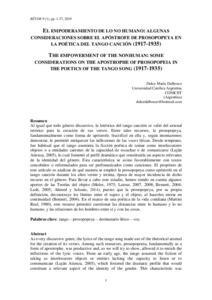Please use this identifier to cite or link to this item:
https://repositorio.uca.edu.ar/handle/123456789/9233| Título: | El empoderamiento de lo no humano : algunas consideraciones sobre el apóstrofe de prosopopeya en la poética del tango canción (1917-1935) The empowerment of the nonhuman : some considerations on the apostrophe of prosopopeia in the poetics of the tango song (1917-1935) |
Autor: | Dalbosco, Dulce María | Palabras clave: | TANGO; CANCIONES; LETRAS; POESIA; LITERATURA ARGENTINA | Fecha de publicación: | 2019 | Editorial: | Asociación Argentina de Retórica | Cita: | Dalbosco, D. M. El empoderamiento de lo no humano : algunas consideraciones sobre el apóstrofe de prosopopeya en la poética del tango canción (1917-1935) [en línea]. Rétor, 2019, 9 (1). ISSN: 1853-6034. Disponible en: https://repositorio.uca.edu.ar/handle/123456789/9233 | Resumen: | Resumen:
Al igual que todo género discursivo, la letrística del tango canción se valió del arsenal retórico para la creación de sus versos. Entre tales recursos, la prosopopeya, fundamentalmente como forma de apóstrofe, fructificó en ella y, según intentaremos demostrar, le permitió enriquecer las inflexiones de las voces líricas. Desde temprano, fue habitual que el tango asumiera la ficción poética de tomar como interlocutores objetos o a entidades carentes de la capacidad de escuchar o de comunicarse (Luján Atienza, 2005), lo cual fomentó el perfil dramático que constituiría un aspecto relevante de la identidad del género. Esta característica se avino favorablemente con textos concebidos o reformulados para ser perfomatizados como canciones. El propósito de este artículo es analizar de qué manera se empleó la prosopopeya como apóstrofe en el tango canción durante los años veinte y treinta, época de mayor incidencia de dicho recurso en el género. Para llevar a cabo este estudio, hemos tenido en cuenta algunos aportes de las Teorías del objeto (Moles, 1975; Latour, 2007, 2008; Bennett, 2004; Lash, 2005; Ahmed y Schmitz, 2014), puesto que la prosopopeya, por su propia definición, deconstruye los límites entre el sujeto y el objeto, al hacerlos entrar en continuidad (Bennett, 2004). En el marco de una poética de la vida cotidiana (Martini Real, 1980), este recurso permitió cuestionar las distancias entre lo humano y lo no humano, y las relaciones de los hombres entre sí y con las cosas. Abstract: As every discursive genre, the lyrics of the tango song made use of the rhetorical arsenal for the creation of its verses. Among such resources, prosopopoeia, fundamentally as a form of apostrophe, was productive and, as we will try to show, allowed it to enrich the inflections of the lyric voices. From an early age, the tango assumed the fiction of taking as interlocutors objects or entities lacking the capacity to listen or to communicate (Luján Atienza, 2005), which fostered the dramatic profile that would constitute a relevant aspect of the identity of the gender. This characteristic was favorable for texts conceived or reformulated to be perfomatized as songs. The purpose of this article is to analyze how prosopopeia was used as an apostrophe in tango song during the twenties and thirties, the period with the highest incidence of this resource in the genre. To carry out this study, we have taken into account some contributions of the Theories of the Object (Moles, 1975; Latour, 2007, 2008; Bennett, 2004; Lash, 2005; Ahmed & Schmitz, 2014), since the prosopopeia, by its own definition, deconstructs the limits between the subject and the object, by making them enter in continuity (Bennett, 2004). In the context of a Poetic of daily life (Martini Real, 1980), this resource allowed to question the distances between the human and the nonhuman, and the relationships of men with each other and with things. |
URI: | https://repositorio.uca.edu.ar/handle/123456789/9233 | ISSN: | 1853-6034 | Disciplina: | LITERATURA | Derechos: | Acceso abierto | Fuente: | Rétor, Vol.9, No.1, 2019 |
| Appears in Collections: | Artículos |
Files in This Item:
| File | Description | Size | Format | |
|---|---|---|---|---|
| empoderamiento-no-humano-consideraciones.pdf | 205,24 kB | Adobe PDF |  View/Open |
Page view(s)
263
checked on Jan 14, 2026
Download(s)
99
checked on Jan 14, 2026
Google ScholarTM
Check
This item is licensed under a Creative Commons License

